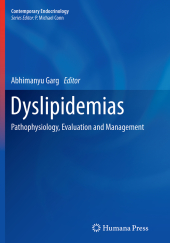 Neuerscheinungen 2016Stand: 2020-02-01 |
Schnellsuche
ISBN/Stichwort/Autor
|
Herderstraße 10
10625 Berlin
Tel.: 030 315 714 16
Fax 030 315 714 14
info@buchspektrum.de |

Abhimanyu Garg
Dyslipidemias
Pathophysiology, Evaluation and Management
Herausgegeben von Garg, Abhimanyu
Softcover reprint of the original 1st ed. 2015. 2016. xvi, 525 S. 26 SW-Abb., 101 Farbabb., 74 Tabellen
Verlag/Jahr: SPRINGER, BERLIN; HUMANA PRESS 2016
ISBN: 1-493-95852-6 (1493958526)
Neue ISBN: 978-1-493-95852-8 (9781493958528)
Preis und Lieferzeit: Bitte klicken
Dyslipidemias: Pathophysiology, Evaluation and Management provides a wealth of general and detailed guidelines for the clinical evaluation and management of lipid disorders in adults and children. Covering the full range of common through rare lipid disorders, this timely resource offers targeted, practical information for all clinicians who care for patients with dyslipidemias, including general internists, pediatric and adult endocrinologists, pediatricians, lipidologists, cardiologists, internists, and geneticists. For the last twenty years, there has been a growing recognition worldwide of the importance of managing dyslipidemia for the primary and secondary prevention of atherosclerotic vascular disease, especially coronary heart disease. This has been mainly due to the publication of the guidelines of National Cholesterol Education Program´s Adult Treatment Panel and Pediatric Panel from the United States. These guidelines have stimulated generation of similar recommendations from all over the world, particularly Europe, Canada, Australia and Asia. Developed by a renowned group of leading international experts, the book offers state-of-the-art chapters that are peer-reviewed and represent a comprehensive assessment of the field. A major addition to the literature, Dyslipidemias: Pathophysiology, Evaluation and Management is a gold-standard level reference for all clinicians who are challenged to provide the best care and new opportunities for patients with dyslipidemias.
Chapter 1. Lipoprotein Physiology
Chapter 2. Epidemiology of Blood Lipids and Lipoproteins
Chapter 3. Lipoprotein(a)
Chapter 4. Lipoproteins and Cardiovascular Disease Risk
Chapter 5. Detection and Treatment of Children and Adolescents with Dyslipidemia
Chapter 6. Type 2 Diabetes Mellitus and Dyslipidemia
Chapter 7. Type 1 Diabetes Mellitus and Dyslipidemia
Chapter 8. Dyslipidemia in Chronic Kidney Disease and Nephrotic Syndrome
Chapter 9. Dyslipidemia in HIV-infected Patients
Chapter 10. Monogenic Hypercholesterolemia
Chapter 11. Primary Hypertriglyceridemia
Chapter 12. Genetic Disorders of HDL Metabolism
Chapter 13. Sitosterolemia and Other Rare Sterol Disorders
Chapter 14. Genetic Abetalipoproteinemia & Hypobetalipoproteinemia
Chapter 15. Drug-induced Dyslipidemia
Chapter 16. Lipodystrophies and Dyslipidemias
Chapter 17. Novel Genes for Dyslipidemias: Genome-Wide Association Studies
Chapter 18. Perspectives on Cholesterol Guidelines
Chapter 19. Nutrition and Coronary Heart Disease Prevention
Chapter 20. Phytosterol Therapy
Chapter 21. N-3 Fatty Acids: Role in Treating Dyslipidemias and Preventing Cardiovascular Disease
Chapter 22. Polyphenols for Cholesterol Management
Chapter 23 - Dietary Supplements for Cholesterol Management
Chapter 24. Statins: Risk-Benefits and Role in Treating Dyslipidemias
Chapter 25. Fibrates: Risk-Benefits and Role in Treating Dyslipidemias
Chapter 26. Niacin: Risk-Benefits and Role in Treating Dyslipidemias
Chapter 27. Bile Acid Sequestrants: Risk-Benefits and Role in Treating Dyslipidemias
Chapter 28. Cholesterol Absorption Inhibitor-Ezetimibe: Risk-Benefits and Role in Treating Dyslipidemias
Chapter 29. Low Density Lipoprotein (LDL) Apheresis
Chapter 30. Novel Lipid Lowering Agents
Abhimanyu Garg, MBBS, MD
Professor of Internal Medicine
UT Southwestern Medical Center
Department of Internal Medicine
5323 Harry Hines Blvd
Dallas, TX 75390
TEL 214-648-2895


